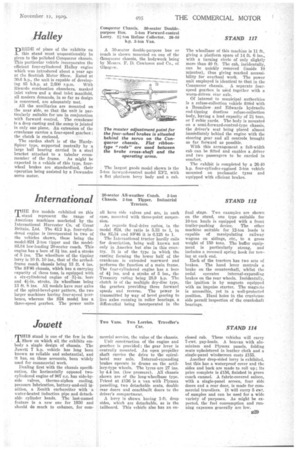International
Page 167

If you've noticed an error in this article please click here to report it so we can fix it.
THE five models exhibited on this stand represent the range of American machines marketed by the International Harvester Co. of Great Britain, Ltd. The 43.2 h_p, four-cylintiered engine is incorporated in two of the vehicles shown, these being the model-S24 2-ton tipper and the modelSL84 low-loading 20-seater coach, This engine has a bore of 31 ins, and a stroke of 5 ins. The wheelbase of the tipping lorry is 10 ft. 10 ins., that of the archedframe coach chassis being 13 ft. 4 ins. The SF46 chassis, which has a carrying capacity of three tons, is equipped with a six-cylindered engine of 3-in bore and 43-in, stroke, its wheelbase being 13 ft.-8 ins. All models have rear axles of the spiral-bevel-gear pattern, the two larger machines having four-speed gearboxes, whereas the 824 model has a three-speed gearbox. The power units
all have side valves and are, in each case, mounted with three-point suspension.
As regards final-drive ratios, in the model 824, the ratio is 5.33 to 1, in the SL34 and SP46 it is 6.125 to 1.
The International tractor hardly calls for description, being well known not only in America but also in this country. It is of the type in which the casting forming the lower half of the crankcase is extended rearward and performs the function of a Main frame. The four-c.vlindered engine has a bore of 41 ins, and a stroke of 5 ins., the Treasury rating being 28.9 h.p. The clutch is of the multiple dry-disc type, the gearbox providing three forward speeds and reverse. The power is transmitted by way of bevel gearing to live axles running in roller bearings, a differential being incorporated in the
final stage. Two examples are shown on the stand, one type suitable for 10-ton hauls is equipped -with a front
trailer-pushing device. The • other machine suitable for 12-ton loads is capable of manipulating railway wagons on sidings, etc:, to a gross weight of 150 tons. The buffer equipment is particularly strong, and includes a recessed spring hook for towing at each end.
Each of the tractors has two sets of brakes. The hand lever controls a brake on the countershaft, whilst the pedal operates internal-expanding brakes on the rear wheels. Incidentally, the ignition is by magneto equipped with an impulse starter. The magneto is accessible., yet in a well-protected position. Hand holes in the crankcase side permit inspection of the crankshaft bearings.








































































































































































































































































































































